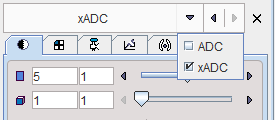Diffusion-weighted MR imaging (DWI) is a well established tool in the examination of the CNS. It is considered useful for the detection of acute ischaemic stroke as well as for the characterization and differentiation of brain tumors and intracranial infections. The Diffusion ADC (DWI MRI) model supports the analysis of simple DWI data without diffusion tensor information (DTI), resulting in ADC (apparent diffusion coefficient) maps.
Acquisition and Data Requirements
The reading of DWI images with the related gradient information can be a severe challenge. Manufacturers apply proprietary encoding schemes, and research toolkits use their own specific formats for which scientist have developed conversion functions. PXMOD supports DWI data loading in a wide range of formats. PMOD tries to extract the gradient vectors from the images, if they are DICOM. If this fails or the data are in a different format, the gradient information has to be provided in a text file in preprocessing.
Image Data |
MR data acquired with a DWI sequence. At least one b-zero image and a diffusion weighted image in the acquisition is required. |
Model Preprocessing
When arriving at model preprocessing, the gradient information should be checked as illustrated below. In this example the directions as well as the gradient size were extracted from DICOM.

If the information about the B-values is not present, it should be prepared in one of the supported formats and then configured as illustrated below.

The ? button to the right provides a description of the supported gradient text formats which is reproduced below. B-values have to be specified in [s/m2].
Camino b-vector scheme |
This text file contains four columns of data. The first three columns are the b-vectors for x, y, and z. The fourth column is for the b-value. |
DSI Studio b-table |
This text file contains four columns of data. The first column is for the b-value. The following columns are the b-vectors for x, y, and z. |
FSL b-vector |
This text file contains the b-vectors for x, y, and z in three rows. As PMOD does not support b-value files as a separate input you may add the b-values as a fourth row. |
DTI parameter file |
This option retrieves b-vectors and b-values from a DTI Studio parameter file. |
Gradient directions |
This general option will accept text files with three to five columns. The first three columns are the b-vectors for x, y, and z. A four-columns file is assumed to have the b-values in the last column. A five-columns file is assumed to have gradient indexes in the first column. This option accepts gradient tables exported from the Pmod Info Dialog. |
ParaVision |
This option retrieves b-vectors and b-values from the ParaVision Parameter List file. |
NRRD header |
This option retrieves b-vectors and b-values from the DWMRI section of the NRRD formatheader file. |
PMOD DB |
This option retrieves b-vectors and b-values from a gradient table file stored to PMOD database. The data in the file is arranged in five columns as in Gradient directions file. Comment lines start with #. |
Model Configuration
Only one parametric map can be generated
![]()
ADC |
Mean apparent diffusion coefficient. |
However, pixelwise calculation adds an additional result xADC which can be found in the list of parametric maps.

xADC |
Dynamic series containing the apparent diffusion coefficient calculated from each of the acquisitions. |